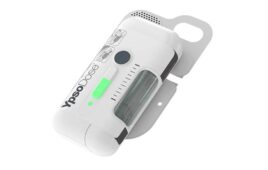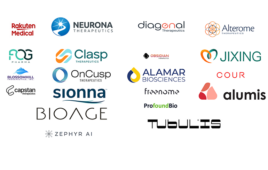Regeneron Pharmaceuticalsannounced that the Phase 3 Panorama trial evaluating Eylea (aflibercept) Injection in patients with moderately severe and severe non-proliferative diabetic retinopathy (NPDR) met its one-year (52-week) primary endpoint and key secondary endpoints. On the primary endpoint at one year, 80 percent and 65 percent of patients receiving Eylea on an every 8- and every 16-week interval (after an initial monthly dosing period), respectively, experienced a two-step or greater improvement from baseline on the Diabetic Retinopathy Severity Scale, compared to 15 percent of patients receiving sham injection (p<0.0001).
Regarding the two key secondary endpoints, which achieved statistical significance based on the pre-specified hierarchical analysis, treatment with Eylea also reduced vision-threatening complications (VTCs) by 82 percent-85 percent and the development of center-involved diabetic macular edema (CI-DME) by 68 percent-74 percent compared with sham injection.
- The development of VTCs (proliferative diabetic retinopathy and anterior segment neovascularization) was 3 percent for the Eylea every 8-week group, 4 percent for the Eylea every 16-week group, and 20 percent for the sham injection group (p<0.001).
- CI-DME occurred in 8 percent of the Eylea every 8-week group, 7 percent of the Eylea every 16-week group, and 26 percent of the sham injection group (p<0.001).
- These events collectively occurred in 11 percent and 10 percent of patients receiving Eylea every 8 weeks or every 16 weeks, respectively, compared to 41 percent of patients receiving sham injection (p<0.001).
“Blindness caused by diabetes is one of the most feared consequences of this disease,” said George D. Yancopoulos, M.D., Ph.D., president and chief scientific officer of Regeneron. “In this trial of patients with diabetic eye disease and normal vision, it is notable that without treatment more than one third of patients developed a vision-threatening complication or diabetic macular edema within one year. Eylea was able to reduce these complications by 68 percent-85 percent even with every four-month dosing, and moreover was able to reverse the anatomic severity of the disease. These results point to the potential value of earlier intervention in diabetic retinopathy and may in the future change the way retina specialists treat this disease.”
The average number of injections in the first year was 8.6 (of 9 planned) for the Eylea every 8-week group and 5.5 (of 6 planned) for the Eylea every 16-week group.
Adverse events were consistent with the known profile of Eylea. Serious ocular treatment-emergent adverse events in the study eye occurred in 0 and 1 patients in the Eylea treatment groups and 1 patient in the sham injection group. Ocular inflammation occurred in 1 patient in each Eylea treatment group and 0 patients in the sham injection group. Anti-Platelet Trialists’ Collaboration (APTC)-defined arterial thromboembolic treatment-emergent events occurred in 4 and 2 patients in the Eylea treatment groups and 5 patients in the sham injection group.
Regulatory Update on Eylea Pre-filled Syringe
Regeneron also announced today that FDA issued a complete response letter (CRL) regarding the Chemistry, Manufacturing and Controls (CMC) Prior-Approval Supplement (PAS) for the Eylea pre-filled syringe. The CRL requested additional information regarding manufacturing and supply processes and the completion of a usability study evaluating a single injection of the Eylea pre-filled syringe in approximately 30 patients. Regeneron expects to compile all the requested information and resubmit the PAS in early 2019 and continues to expect a 2019 launch of the Eylea pre-filled syringe.
About the Panorama trial
Panorama is an ongoing, pivotal, double-masked, randomized, two-year trial that enrolled 402 patients and is designed to investigate Eylea for the improvement of moderately severe to severe NPDR in patients without DME, compared to sham injections. Details on trial design include:
- Three treatment arms – An observational sham injection group and two Eylea treatment groups. Eylea was dosed every 8 weeks (following five initial monthly doses) or every 16 weeks (following three initial monthly doses and one 8-week interval).
- Primary endpoint – The primary endpoint was the proportion of patients who experienced a two-step or greater improvement in the diabetic retinopathy severity score (DRSS) from baseline for the combined Eylea treatment groups at week 24, and for each Eylea treatment group separately (every 8-week group and every 16-week group) at week 52. The DRSS is a systematic grading scale to assess the severity of diabetic retinopathy based on photographs of the retina following a dilated eye exam.
- Secondary endpoints – These include assessment of whether Eylea reduced VTCs (proliferative diabetic retinopathy and anterior segment neovascularization) or development of CI-DME, as well as its impact on other anatomic effects, visual acuity improvement, and safety.
One-year results from Panorama will be submitted for presentation at a future medical congress. Six-month Panorama results were previously reported in March 2018. A supplemental Biologics License Application (sBLA) for Eylea in diabetic retinopathy based on 24-week results was accepted for review by the U.S. FDA with a target action date of May 13, 2019. Regeneron also plans to submit the 52-week results to the FDA.
The safety and efficacy of Eylea in diabetic retinopathy in patients without diabetic macular edema (DME) have not been fully evaluated by any regulatory authority.
A separate ongoing trial sponsored by the Diabetic Retinopathy Clinical Research Network known as Protocol W is also evaluating Eylea for the treatment of NPDR in patients without DME.
About Diabetic Retinopathy (DR)
Approximately eight million people live with DR, a disease characterized by microvascular damage to the blood vessels in the retina often caused by poor blood sugar control in people with diabetes. The disease generally starts as NPDR and often has no warning signs or symptoms. NPDR may progress to PDR, a stage of the disease in which abnormal blood vessels grow onto the surface of the retina and potentially cause severe vision loss.
DME can occur at any stage of DR as the blood vessels in the retina become increasingly fragile and leak fluid, potentially causing visual impairment. In the U.S., approximately 1.5 million adults are diagnosed with DME, while approximately 3.5 million people have DR without DME.
About Eylea (aflibercept) Injection
Eylea (aflibercept) Injection is a vascular endothelial growth factor (VEGF) inhibitor formulated as an injection for the eye. It is designed to block the growth of new blood vessels and decrease the ability of fluid to pass through blood vessels (vascular permeability) in the eye by blocking VEGF-A and placental growth factor (PLGF), two growth factors involved in angiogenesis. In the United States, Eylea is the market-leading FDA-approved anti-VEGF treatment for its approved indications and is supported by a robust body of research that includes seven pivotal Phase 3 trials.
(Source: Regeneron Pharmaceuticals, Inc.)
Filed Under: Drug Discovery and Development




